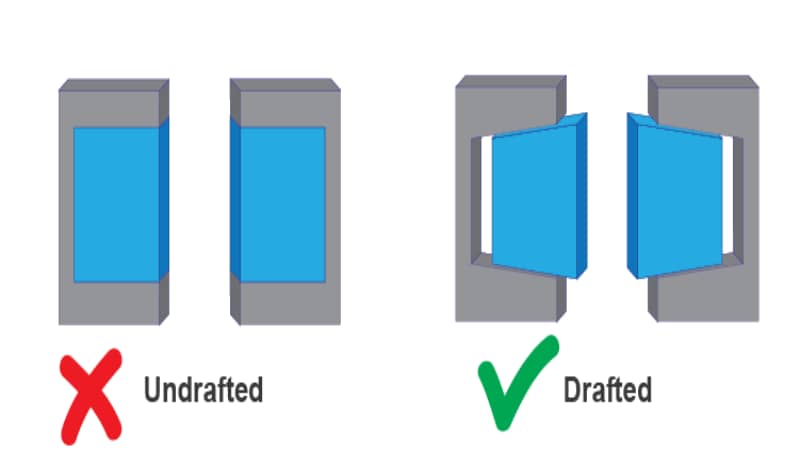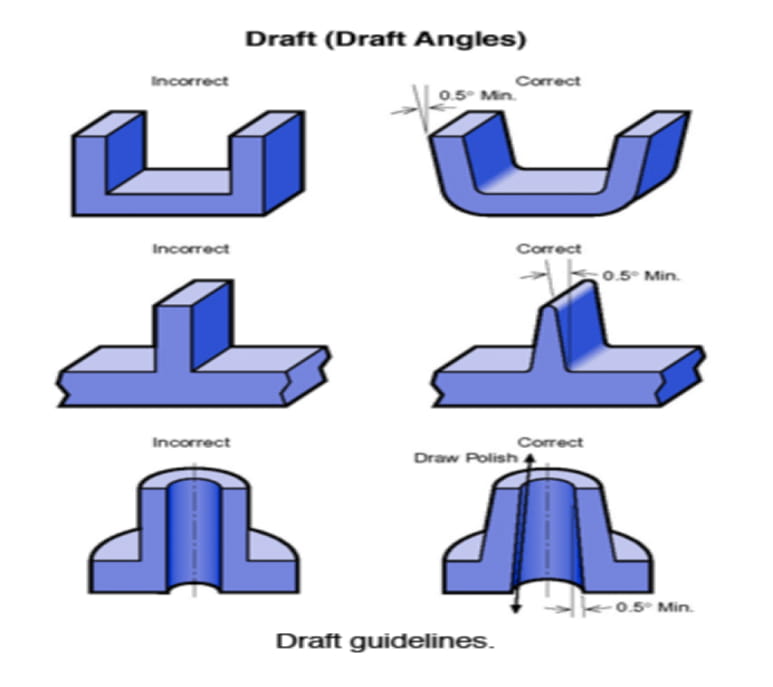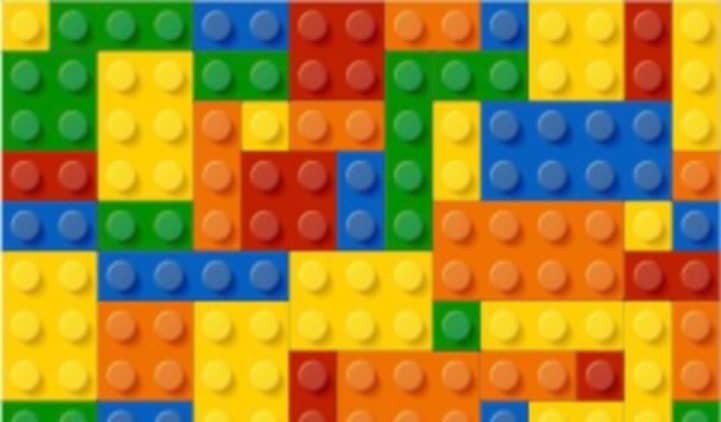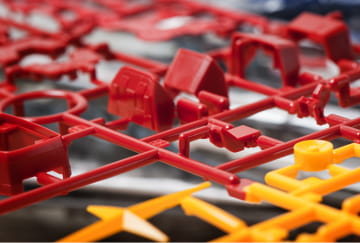When we talk about the best practices for plastic injection molding parts, some are unavoidable. Topping that list is usually the injection molding draft angle. Every injection molding design is aimed towards manufacturability. Therefore, you must consider every step of the process.
Although your parts may form correctly in the mold, problems may come up during the ejection process. This may give rise to unwanted defects in the molded parts. A draft angle will help avoid many of these unwanted issues. In this article, we will discuss the benefits of injection angles and a design guide for easy injection of your parts.
While we’ll cover more about the benefits later, let’s briefly describe a draft angle.
What is a Draft Angle?
A draft angle refers to the slant applied to the sides of most features of injection molded parts. Positioning of the injection angles is such that they run towards the direction of the mold’s pull and parting line. They help to release the molded parts from the mold easily.

99% of your injection molding design will require draft angle injection molding for a successfully made part. The angle tapers on the molded part’s surfaces. Therefore, the part can easily slide across the mold’s cavities and cores as you’re demolding.
Benefits of a Draft Angle
Many times, draft angles may create a conflict of interest. Molders like and recommend draft angles. However, mold-makers find it daunting to machine the angles on all cavity and core surfaces. Some also believe that draft angles may complicate the part design.
However, it is crucial to note that draft angles offer an extensive range of benefits. They are vital to ensure that molded parts meet the required quality standard. Without a draft, you increase the chances of having injection molding issues. This may unnecessarily increase the cost of production and lead time.
Problems often arise from friction and vacuums when there is no draft designed into the part. These can damage your part. In extreme cases, the mold is also affected. Plastics shrink before cooling. Therefore, some portions of your part will likely pull away from the mold. Other portions will grip the core.
A draft angle allows you to use a simple push on the ejector pins to pop your part out of the mold. This way, you will prevent the part’s surfaces from being dragged along the mold when ejected. Friction between your part’s surface and the mold’s surface can cause scratches and affect your part’s appearance.

Furthermore, injection angles prevent the formation of vacuums during ejection. The absence of the draft may cause ejection pins to push on the component until the stressing of the vacuum occurs. This may lead to the bending, breaking, or warping of the part when it is being ejected.
Adding draft angles to your design will help you avoid these problems. Therefore, you can improve the cosmetic finishes of your part and reduce the cost of production. A draft angle also helps you prevent elaborate and expensive ejection setups.
To sum up, adding injection angles to your design:
- Ensures smooth, uniform, unscratched finishes when required
- Reduces the possibility of damage to parts due to friction during ejection
- Ensures the uniformity and integrity of other surface textures and finishes
- Reduces wear and tear on the molded part
- Reduces the chances of damaging the mold
- Minimizes warping to your geometry
- Reduces overall cooling time by eliminating or reducing the need for elaborate ejection setups
- Offer both direct and indirect reductions to overall production cost
Draft Angle Design Guide and Best Practices
First, you must note that there is no single adequate draft angle for all molded parts. Every individual part has its unique draft requirements. Larger parts may require more drafts than smaller ones. Also, thin-walled parts molded at high pressures may require more draft than those molded at lower pressures.

With that in mind, here are some general guides and best practices for draft design:
1. Most Parts Require a Draft Angle of 1½ to 2 Degrees
This is a rule of thumb that applies to molded parts with depths of up to 2 inches. With this size, a draft of about 1½ degrees is enough for easy release of parts from the mold. This helps to prevent damage to the parts when the thermoplastic material shrinks.
2. Draft Angle Should Average Additional Degree for Every Inch of Depth
This practice works best for larger or deeper parts. These kinds of parts require more drafts to account for the added surface area. The additional injection angles also account for the friction that occurs during mold release.
3. Draft Angle Should Be Present Towards the “Top” of the Mold
This means that the draft should follow the mold’s direction moving up or away as the separation occurs. Suppose you’re familiar with hollow boxes with drafted walls. In that case, you’ll notice that the open top is slightly wider than the bottom. This is a result of a correctly applied draft.
4. Textured Parts Would Usually Require More Draft
Some parts may have intricate textures designed on their surfaces. Others may have recessed or raised surfaces.

For such components, the draft angle should be added to the optimal 1½ to 2 degrees. The addition should be done at a rate of another 1½ degrees per 0.001’’ (thousandth-inch) of surface depth.
5. Every Component of a Piece Should Have Draft Angles
Materials with complex geometries or parts with tension-easing features should have draft angles. These features include gussets, louvers, ribs, and others. They are all crucial components of a good design. Consequently, any of these features in contact with the mold should incorporate injection angles.
6. Incorporating Draft Angle Two Sides of a Part Offers Even More Benefits
Some materials (such as a solid cylindrical part) often have their parting line in the middle. In this case, both ends of the part should have draft angles. This is because two mold release actions are involved in this kind of operation.
7. Vertical Surfaces Should Have – At The Barest Minimum – Half a Degree of Draft
This guideline is important when the design requires a uniform angle from the bottom to the top of the vertical surface. Half a degree of draft offers an effective compromise for designs that require straight walls. It also helps the part to meet the injection molding requirements.
8. It is Always Advisable to Have a Draft Angle
It is important to reiterate this fact since many designers tend to resist incorporating a draft. Regardless of how small, engineers must always advocate for some degree of the draft. A draft design is always best since it is unlikely for you to find a design case requiring a zero-degree angle. Remember the saying, “Any draft is better than no draft.”
Feature Depth and Minimum Draft Angle in Injection Molding
Several factors influence the selection of draft angles. These factors include wall thickness, wall depth, shrink rates, material selection, finish/texture, ejection, and manufacturing capabilities. The table below shows the feature depth of molded parts and the minimum draft required.
| FEATURE DEPTH | MINIMUM THICKNESS/DRAFT | |||
| 0.25 in. | 0.040 in./0.5° | |||
| 0.5 in. | 0.040 in./1° | 0.060 in./0.5° | ||
| 0.75 in. | 0.040 in./2° | 0.060 in./1° | 0.080 in./0.5° | |
| 1 in. | 0.060 in./2° | 0.080 in./1° | >0.100 in./0.5° | |
| 1.5 in. | 0.080 in./2° | >0.100 in./1° | ||
| 2 in. | >0.100 in./2° |
Conclusion
The aim of this guide is not to discuss draft angles because it is an attractive design feature. Rather, draft angles are important components of successfully designed parts. They ensure effective and high-quality production processes. Disregarding the draft angle can cause a high number of rejected parts. It can also lead to damage to molds. It is always best to stay up to speed on the best practices for injection molding. One of those is the incorporation of draft angle in injection molding.
At RapidDirect, we are injection molding specialists, ready to share our expertise with you. Our engineers have a deep understanding of injection molding best practices, and we incorporate them into our services. Our engineers can adequately assess your designs and offer suggestions. We provide free DfM to ensure that you have the best results from your part design.

Our wide range of manufacturing services includes robust injection molding services. In the case that you’re not sure if your draft angle is enough for your part, we are available for design discussions. Also, we offer general inspection of parts to ensure they are ready for the molding process. All of these services come at competitive prices.
FAQ – Draft Angle for Injection Molding
A draft angle injection molding of 1 degree per side will be beneficial. Highly polished surfaces cause LDPE to stick to cavities and cores. Therefore, drafts of about 1½ degrees will help release the parts easily.
Engineers calculate a draft angle as a degree measurement. In rare cases, the angle is calculated as a millimeter or inch measurement. The calculation occurs from the vertical axis of the mold. It helps to account for the shrinkage of the plastic material.


